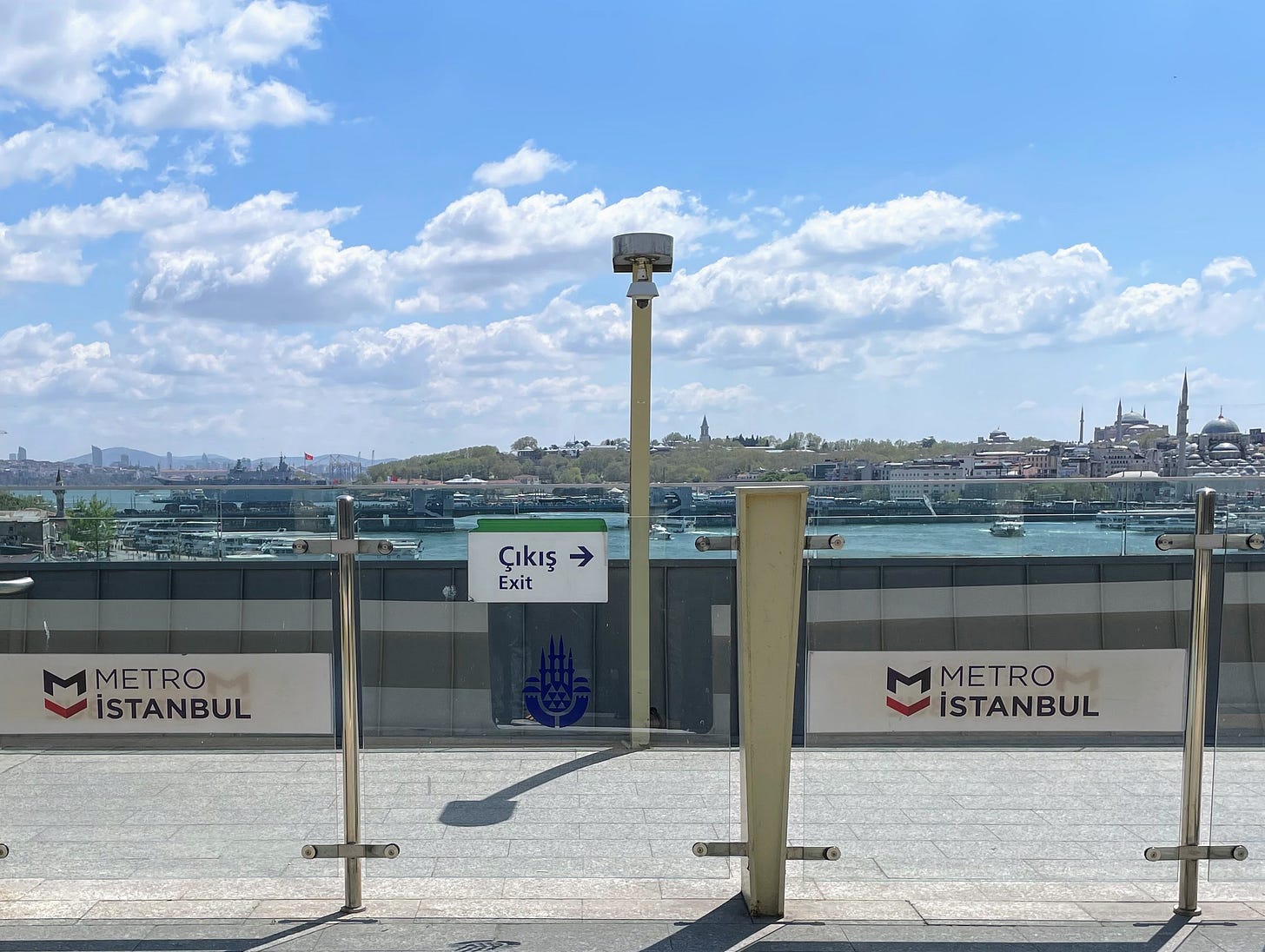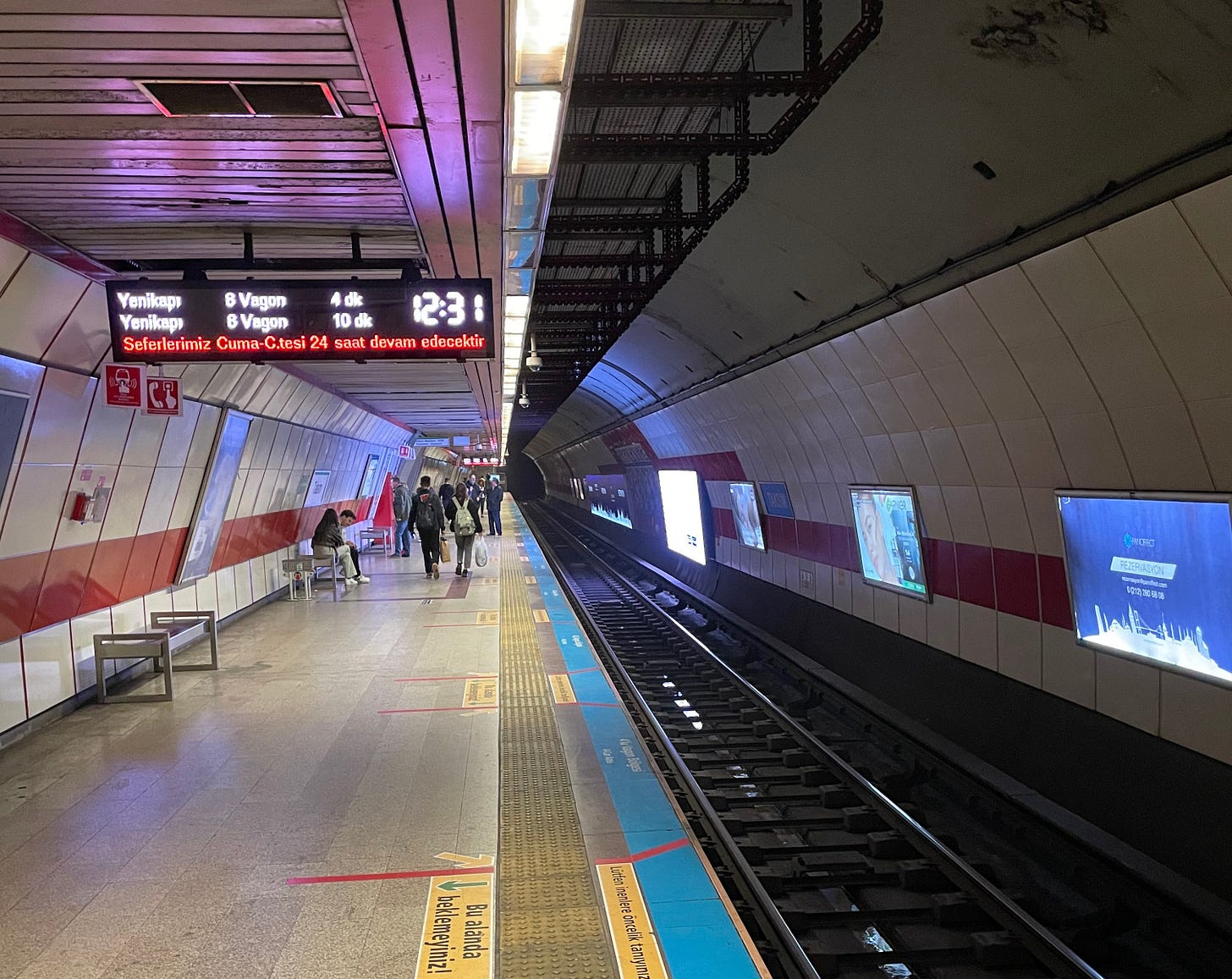America’s Transit Exceptionalism
The rest of the world is building subways like crazy. The U.S. has pretty much given up.
The most spectacular way to cross the Bosphorus is by boat, but the most impressive way is by subway. Istanbul’s Marmaray Line, completed in 2013, links Asia and Europe by way of an eight and a half mile undersea tunnel. The ride is so fast and so smooth, it feels like a hovercraft.
When my dad and I traveled to Istanbul last year, we were prepared to witness the city’s beauty and stand in awe of its history. But what really blew us away was the city’s transit system.
“It’s like a sci-fi movie,” my dad remarked as we rolled above the waters of the Golden Horn on the M2, another relatively new transit line that crosses another iconic body of water in Istanbul. (His take on robotaxis: “It’s like The Invisible Man!”) Even Istanbul’s light rail lines are completely different from their American counterparts. The T1 tram arrives every two or three minutes, and enjoys seamless signal priority that keeps the train moving at all times, except when it’s picking up passengers. The view, once again, is awesome.
For Americans, state-of-the art transit systems like the one in Istanbul are about as familiar as the transporter on “Star Trek.” As the U.S. lavishes billions on highway expansions and subsidizes tricked-out SUVs, other countries are investing in transit systems that are setting new standards for speed, convenience, and technology. Increasingly, transportation is looking like another area of American exceptionalism.
Earlier this month, I wrote a piece in CityLab about the rise of “rapid regional rail.” New transit lines in London, Seoul, Delhi, Guangzhou and numerous other global cities straddle the line between suburban commuter rail and urban metros. They cover long distances at very high speeds — as fast as 100 miles per hour — but with frequencies as good as every three minutes. These systems make big cities feel smaller, allowing riders to effectively teleport across busy neighborhoods to the other side of the metropolis.
But rapid regional rail is just one flavor of transit innovation that’s spreading across the world. Spain and France are automating more and more of their existing subway lines, allowing for increased frequency and lower operating costs. Transit lines in Vienna are being upgraded with platform screen doors, improving rider safety and comfort while people wait for their trains. Three quarters of global metro systems, from Sapporo to Santiago, operate “endless” open gangway trains that increase capacity onboard and allow passengers to spread out.
Name a global city, and it’s probably building miles of new rail transit, oftentimes with much more impressive technical specs than Americans are used to. Rome, Athens, Montreal, Moscow, Mumbai, Sao Paolo, Lagos, Cairo, Tel Aviv, Doha, Shanghai, Bangkok — these diverse cities are unified in their bet that transit is the way of the future.1
It’s a smart bet. High-quality transit is the only way to facilitate upward growth without causing unbearable amounts of congestion. It’s the only way to speed up trips through crowded neighborhoods. And it’s by far the most efficient and straightforward way to reduce pollution and carbon emissions from transportation. As an added bonus, a transit-oriented model of urban growth allows for much more pleasant surface-level streetscapes, with more space for walking, biking, and communing.
On a more philosophical level, these once-in-a lifetime transportation investments signal faith in a better future; that transforming the way people get around cities will pay dividends for generations to come. This faith is lacking in the U.S. — and so is the transit construction.
The opening lines of a 2023 article entitled, “Once a Leader in Urban Rail Investment, the United States Now Trails” by transportation researcher Yonah Freemark sums up the situation:
As late as 1980, the United States had more kilometers of metro lines per capita than all large developed countries but the United Kingdom—thanks in part to large public investments in projects like Washington’s Metro and San Francisco’s BART. In the decades since, both the United States and the United Kingdom have stagnated, falling behind even as other countries, particularly China, but also India and many in Europe and South America, have invested in massive new construction campaigns. Much of the world’s urban areas are rapidly becoming dominated by metro service.
This graph in Freemark’s article tells the same story even more starkly. See the U.S. flatlining in transit miles per capita, while other countries embark on steep growth curves:
These are the statistics underlying the reality that in San Francisco, Washington, D.C., Boston, Atlanta, and many other major cities in the U.S., not a single mile of rail transit is currently under construction.
New York City currently has fewer miles of rail transit than it did in 1940. The city’s exceedingly modest transit expansion plans — a 1 mile extension of the Second Avenue Subway and a light rail line connecting Brooklyn and Queens — are effectively on hold following Governor Kathy Hochul’s cancellation of congestion pricing.
Los Angeles and Seattle are the only cities in the U.S. whose transit development plans come remotely close to those seen in other global cities. And while their future transit maps are impressive, all of those colorful lines don’t mean the same things as the ones on Istanbul’s transit map. LA and Seattle’s light rail lines are not nearly as fast, frequent, or high-capacity as the heavy rail metros being built in other countries.
Nor are they as high-tech. Honolulu is the only city in the U.S. currently building an automated metro line, and it’s doing so at a snail’s pace. New York City just debuted a handful of open gangway trains — a first in the U.S. Platform screen doors only exist on airport people movers.
Why is it so hard for the U.S. to build quality transit?
This is one of the central questions underpinning this newsletter and my book. It’s also something that several other researchers and journalists, like Eric Goldwyn and Jerusalem Demsas, are looking into. There’s no easy answer, though there is a growing consensus around certain factors that are holding America’s transit systems back. In a future post, I’ll describe these factors in depth.
But pointing out the degree of the discrepancy between the U.S. and other countries is an important place to start. Otherwise, there’s a risk of normalizing the nation’s dismal transit status quo.
Yonah Freemark’s “Transit Explorer” site is a great resource for learning about transit projects in cities across the world







"On a more philosophical level, these once-in-a lifetime transportation investments signal faith in a better future; that transforming the way people get around cities will pay dividends for generations to come. This faith is lacking in the U.S. — and so is the transit construction."
Such an important point! When a nation invests in military and endless wars at the expense of urban development and social services, how is there to be optimism about the future?
Thanks for this informative article.
"This is one of the central questions underpinning this newsletter and my book."
Anyone know what book is being referred to here?